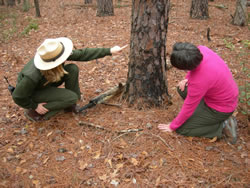
National Fire Plan Success Story
Surviving Scorch: A New Interpretive Program
Congaree National Park, South Carolina
National Fire Plan - Accountability
2010

A visitor gets a close look at a loblolly pine that was burned during a prescribed fire.
Interpretive rangers at Congaree National Park have developed a new interpretive walk that promotes prescribed fire, entitled “Surviving Scorch.” The walk takes place in the uplands of Congaree, where prescribed fire is used as a management tool to restore the upland pine ecosystem, improve habitat for the federally endangered Red-cockaded Woodpecker, and reduce hazardous fuel accumulations.
This program takes visitors into a fire management unit and asks them to observe the forest and compare the burn area with the unburned area. Black burn scars on the bottom of pine trees, such as Loblolly and Longleaf, provide opportunities for park rangers to describe and explain the historic fire regime of the Southeast. Sightings of Red-headed, Red-bellied and Pileated Woodpeckers provide teachable moments when rangers explain the relationship between the endangered Red-cockaded Woodpecker and the fire-dependent Longleaf Pine forests across the Southeast. Dead and down logs remaining unconsumed after the prescribed burn help rangers demonstrate how lightning-caused fires in the Southeast were typically fast-moving, and would likely have passed by damp logs and burned until encountering a natural break like a wetland or floodplain. Visitors are then prompted to think about human-made fire breaks that prevent fires from naturally burning through forests, linking ecological restoration and fuel reduction.
Contact: Corinne Fenner, Park Ranger, (803) 647-3964.